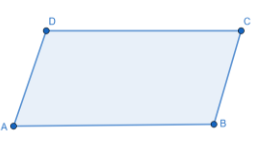
The adjacent sides in the parallelogram are supplementary.
(A). True
(B). False
Answer
521.7k+ views
Hint: The given problem is related to the properties of a parallelogram. The opposite sides of the parallelogram are parallel and any of the remaining sides can act as a transversal. The adjacent angles will be co-interior angles, and the sum of co-interior angles is
Complete step-by-step answer:
Let's consider the parallelogram ABCD.

Let’s consider the sides AD and BC. We know that the opposite sides of a parallelogram are parallel. So, AD ∥ BC . Now, as AD ∥ BC, we can consider the side AB as a transversal. We can see that the angles
Therefore,
Note: Students generally get confused between complementary angles and supplementary angles. Because of this confusion, students can mark the answer as false, which is wrong. Complementary angles are the pair of angles, whose sum is
Complete step-by-step answer:
Let's consider the parallelogram ABCD.

Let’s consider the sides AD and BC. We know that the opposite sides of a parallelogram are parallel. So, AD ∥ BC . Now, as AD ∥ BC, we can consider the side AB as a transversal. We can see that the angles
Therefore,
Note: Students generally get confused between complementary angles and supplementary angles. Because of this confusion, students can mark the answer as false, which is wrong. Complementary angles are the pair of angles, whose sum is
Recently Updated Pages
Master Class 9 General Knowledge: Engaging Questions & Answers for Success

Master Class 9 English: Engaging Questions & Answers for Success

Master Class 9 Science: Engaging Questions & Answers for Success

Master Class 9 Social Science: Engaging Questions & Answers for Success

Master Class 9 Maths: Engaging Questions & Answers for Success

Class 9 Question and Answer - Your Ultimate Solutions Guide

Trending doubts
Fill the blanks with the suitable prepositions 1 The class 9 english CBSE

Difference Between Plant Cell and Animal Cell

Given that HCF 306 657 9 find the LCM 306 657 class 9 maths CBSE

The highest mountain peak in India is A Kanchenjunga class 9 social science CBSE

What is the difference between Atleast and Atmost in class 9 maths CBSE

What is pollution? How many types of pollution? Define it





